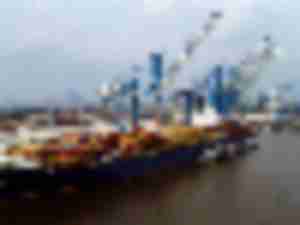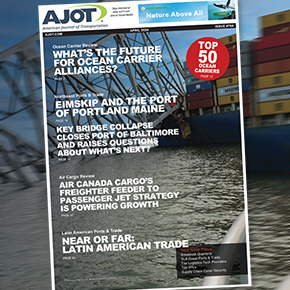
Leavitt is keeping her spirits raised in heading the beverage shippers’ group
Amidst today’s challenging global trade environment, Alison Leavitt is maintaining high spirits as she leads a not-for-profit, 600-member-company association of beverage importers.

Delaware’s Port of Wilmington enhances infrastructure, expands cargo activity
With a newly opened container yard featuring five all-electric rubber-tired gantries, Delaware’s Port of Wilmington is handling a broadening array of cargos at its longtime site at the confluence of the Delaware and Christina rivers while advancing plans for an all-new marine terminal a few miles upriver.

TransGlobal Foods executive touts benefits of the Port of Philadelphia
As vice president of global procurement for TransGlobal Foods Inc., Christopher Dillon is sold on the “can-do” approach of the Port of Philadelphia, making him an ideal ambassador for PhilaPort in his dual roles as president of the World Trade Association of Philadelphia and its Ship Philly First initiative.

PhilaPort handling record volumes, looking to benefit from funding boost
Already handling record cargo volumes, the Port of Philadelphia, marketed as PhilaPort, is looking to further enhance its infrastructure thanks to a newly announced injection of nearly a quarter of a billion dollars of Commonwealth of Pennsylvania funding.

Florida Gulf Coast ports bustle with ever-diversifying activities
Seaports along Florida’s Gulf Coast are bustling with an increasingly diverse spectrum of activities, handling far more than burgeoning containerized cargo volumes.

Planning, innovation help meet challenges in shipment of project, breakbulk cargos
As the world begins to emerge from the COVID-19 pandemic, third-party logistics leaders are turning to time-honored approaches entailing collaborative planning and innovative solutions to meet such present challenges as skyrocketing freight rates and tight truck capacity in keeping project and breakbulk cargo shipments moving.

South Carolina’s Port of Charleston delivering big-ship-handling capacity
With this year’s opening of the first U.S. greenfield container terminal in more than a decade plus significant modernization of its venerable Wando Welch Terminal, the South Carolina Ports Authority’s Port of Charleston is exceptionally positioned to fluidly move burgeoning volumes on and off megacontainerships.

North Carolina’s Port of Wilmington offering supply chain diversification
In these challenging times, when shippers are assertively seeking supply chain diversification, the expanding facilities of the North Carolina State Ports Authority’s Port of Wilmington are offering a highly efficient, congestion-free alternative for moving both temperature-controlled and nonrefrigerated cargos.

Rail links keep cargo moving in and out of Midwest ports
Even absent traditional intermodal container activity, rail links offer vital connections for proficiently moving cargo in and out of Midwest lake and river ports. And leadership of Port Milwaukee is hoping a sought-after intermodal facility will further rail’s role in the region.

Finished vehicle industry grappling with unknowns
As the automotive supply chain grapples with challenges ranging from import volume vicissitudes to continuing COVID-19 pandemic impacts, a quartet of roll-on/roll-off cargo veterans with more than a century of combined industry experience offers hope that a return to some level of normalcy is not far away.
© Copyright 1999–2024 American Journal of Transportation. All Rights Reserved
